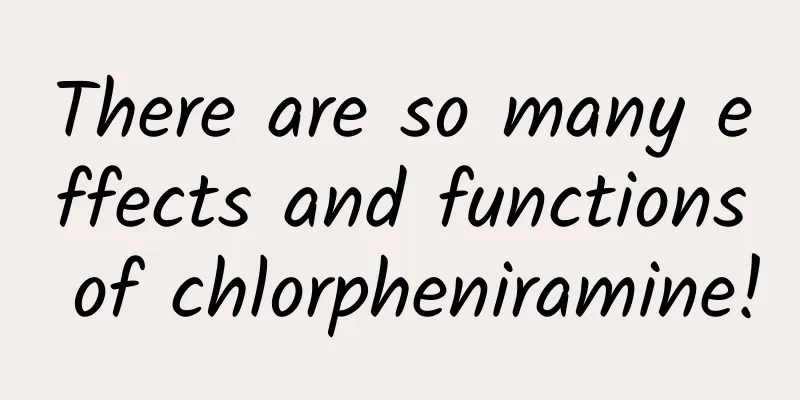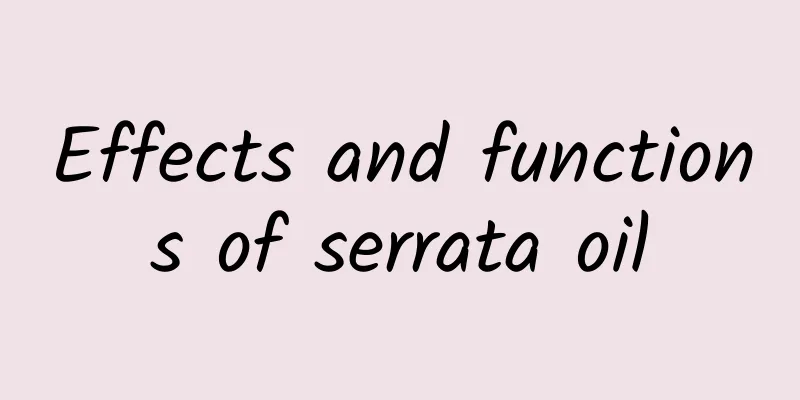There are so many effects and functions of chlorpheniramine!

|
The scientific name of Chlorpheniramine is Chlorpheniramine. This drug has many benefits to the body, such as a sedative effect and a certain inhibitory effect on the human central nervous system. Therefore, it is used in medicine to treat a variety of diseases. However, authoritative doctors say that there are many precautions when using this drug, and the relevant contraindications must be kept in mind, and it must not be used incorrectly. 1. The efficacy and function of chlorpheniramine What are the effects and functions of chlorpheniramine? The efficacy and function of chlorpheniramine is actually used to fight allergies. The antihistamine effect of chlorpheniramine is mainly used to fight allergies. Chlorpheniramine is one of the strongest antihistamines. Its sedative effect is weaker than that of promethazine, and it also has certain anticholine effects. It is similar to diphenhydramine but has a milder CNS depressant effect. It may induce epilepsy and is contraindicated in patients with epilepsy. It is an antihistamine with the same main effect as diphenhydramine, but its sedative effect is generally weaker and its side effects are smaller than diphenhydramine. It is mainly used for various allergic diseases, such as insect bites, drug allergies, etc. It can also be combined with other Chinese and Western medicines to treat colds, etc. Use with caution in lactating women, patients with glaucoma, hypertension, hyperthyroidism, and prostatic hypertrophy. During the medication period, you are not allowed to drive a car, boat, airplane or other motor vehicle or operate machinery. Chlorpheniramine can help people constrict the blood vessels on the nasal mucosa, reduce some inflammatory exudates in the body, and effectively help people relieve nasal congestion, runny nose, sneezing and other adverse symptoms. Therefore, it is necessary to understand the efficacy and effects of Chlorpheniramine. Under normal circumstances, when it comes to the use of this type of Chlorpheniramine tablets, it is important to note that people can gradually stop using it after their nasal symptoms have been alleviated. Although chlorpheniramine has many benefits and effects, some people may experience adverse conditions when using this drug, such as mild dry mouth, dizziness, nausea, drowsiness, etc., or skin bruises. However, such conditions are still rare in clinical practice, and it is normal for most people to use it. 2. The role of chlorpheniramine: Chlorpheniramine (Chlorpheniramine) has antihistamine effect and is mainly used to fight allergies. Chlorpheniramine is one of the strongest antihistamines. Its sedative effect is weaker than that of promethazine, and it also has certain anticholine effects. It is similar to diphenhydramine but has a milder CNS depressant effect. It may induce epilepsy and is contraindicated in patients with epilepsy. Use with caution in lactating women, patients with glaucoma, hypertension, hyperthyroidism, and prostatic hypertrophy. During the medication period, you are not allowed to drive a car, boat, airplane or other motor vehicle or operate machinery. It is an antihistamine with the same main effect as diphenhydramine, but its sedative effect is generally weaker and its side effects are smaller than diphenhydramine. It is mainly used for various allergic diseases, such as insect bites, drug allergies, etc. It can also be combined with other Chinese and Western medicines to treat colds, etc. 3. Side effects: Adverse reactions are similar to those of diphenhydramine, but weaker. Chlorpheniramine can induce epilepsy, so it is contraindicated in patients with a history of epilepsy. You should not drive a vehicle or do work that requires high concentration while taking the medicine. Propylamines include brompheniramine, dimethoprim, pheniramine, and triprolidine, which are strong H1 receptor antagonists with sedative effects. Ethanolamines include trimethobenzamine, carbinoxamine, and doxylamine, which have significant sedative and anticholine effects and are less likely to have gastrointestinal side effects. Ethylenediamines, including mepyrilamine, clopidogrel, antazoline, and ciscloidine, have moderate sedative activity and can cause intestinal disturbances and photosensitivity reactions. Phenothiazines include paracetamol, promethazine, propionazine, and mequitazine, which have significant anticholine and antiemetic effects and can cause sedation and photosensitivity reactions. Piperazines include cetirizine, buclizine, and meclizine, which have antiemetic effects. Others include astemizole, azatadine, terfenadine, avivastin, bamipine, and loratadine, which are highly selective H1 receptor antagonists. It is rapidly and completely absorbed after oral administration, takes effect within 15-60 minutes, reaches peak blood concentration within 2.5-6 hours, has obvious first-pass effect, bioavailability of 25%-50%, t1/2 of 30.3 hours, protein binding rate of about 70%, and is mainly metabolized by the liver. Metabolites have no pharmacological activity and are partially excreted unchanged in the urine. |
<<: What are the effects and functions of Zhongsheng Pills?
>>: What are the functions and effects of Zhibai Dihuang Pills?
Recommend
Overweight, the National Health Commission takes action! Have you fallen into these weight loss "pitfalls"?
On March 9, the 3rd Session of the 14th National ...
There are 5 super carcinogens hidden around us. Check if you eat them often!
Have you ever paid attention to the carcinogens a...
The efficacy and function of Da Tou Gu Xiao
Nowadays, our living standards are constantly imp...
Proving Einstein wrong again! Scientists verify the famous Bell test in superconducting circuits for the first time
In 2022, three physicists were awarded the Nobel ...
The efficacy and function of Plantago asiatica[picture]
Friends who don’t know Plantago seed [Picture] wi...
These 4 overnight dishes are too dangerous, it is better to waste them than to eat them! They can damage the liver and kidneys and the intestines...
This article was reviewed by Pa Li Ze, chief phys...
The efficacy and function of wild peony
Most Chinese medicinal materials have good effect...
CMI: 2017 B2B Content Marketing Report
199IT original compilation The Content Marketing ...
The efficacy and function of Sapium wilfordii
As for Sapium wilfordii, I think some people may ...
How to preserve fresh Schisandra chinensis
We all know that the medicinal value of Schisandr...
What can a telescope see? It's more "explosive" than you think
From the first time human ancestors looked up at ...
The efficacy and function of the root of Thuja palm
The root of Thuja palmii is a kind of traditional...
The efficacy and function of pumpkin root
Do you know what pumpkin root is? It is a kind of...
Why do I see strange patterns when I rub my eyes?
Long working or studying time People's eyes a...









